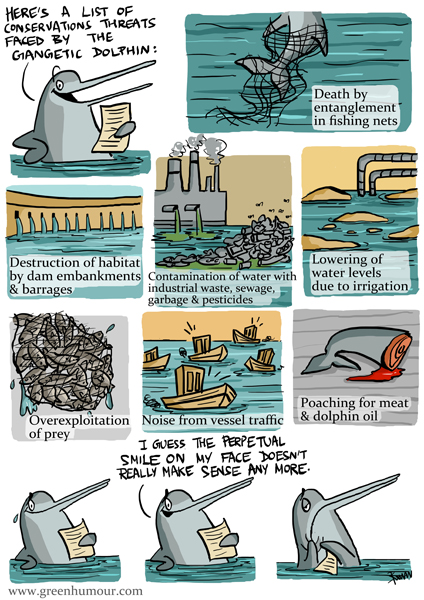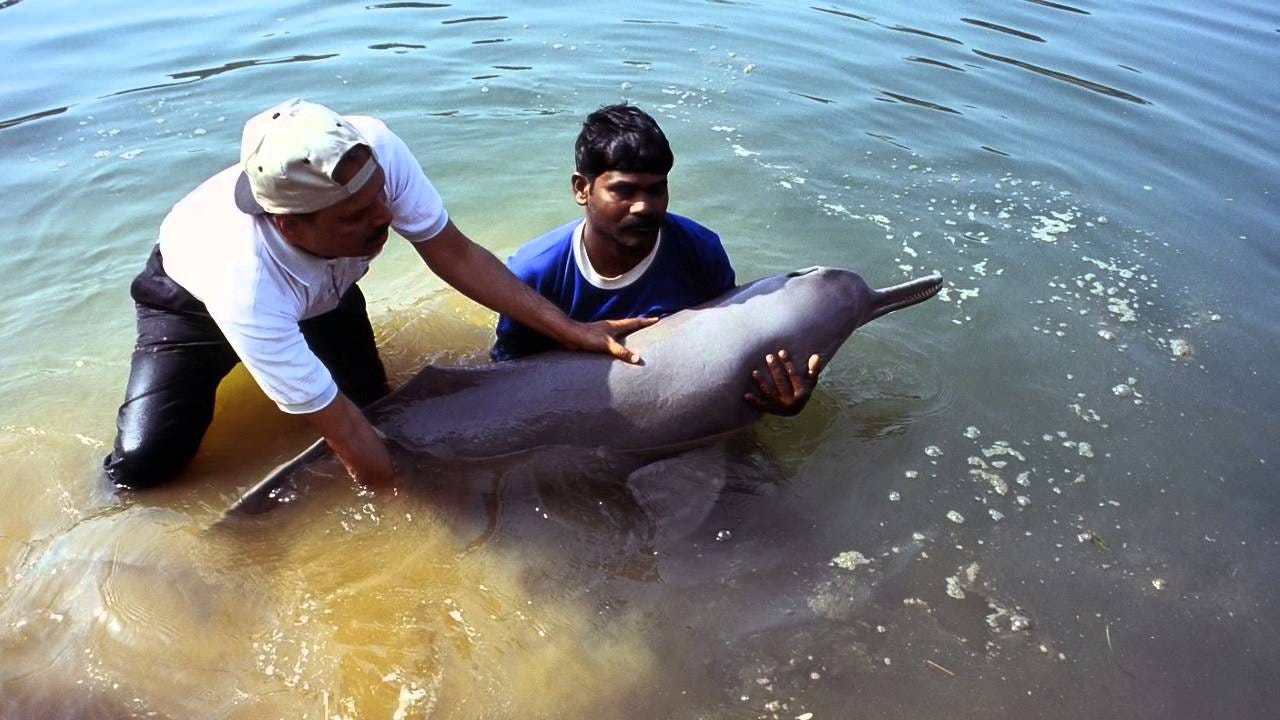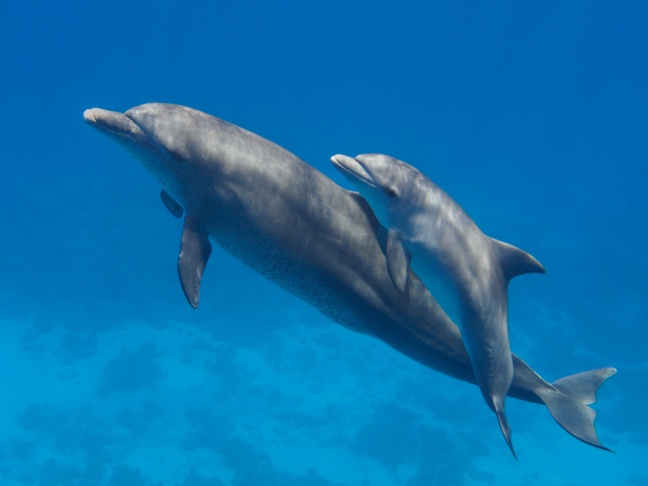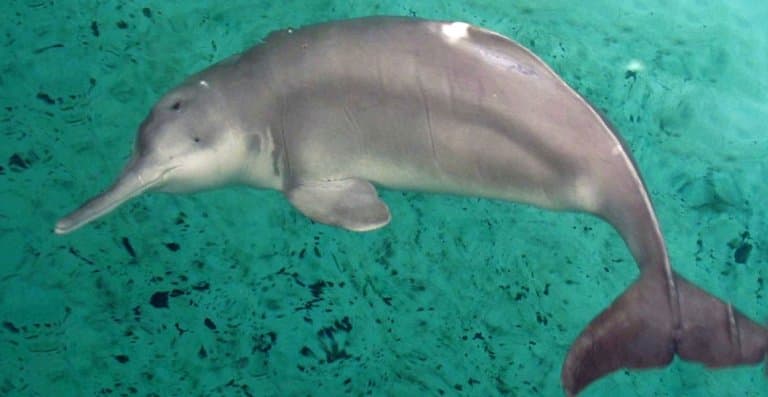Table of contents
Ganges river dolphin (Platanista gangetica gangetica) is a fascinating freshwater creature and, sadly, an endangered species.
They are known as the “Tiger of the Ganges” for the role it plays as a top predator, and because it is an ecosystem indicator species – much like a tiger is in a forest.
It is legally protected in all countries within which it is found. Both Indus and Ganges river dolphins are considered to be living fossils, as they are the most ancient dolphin species still alive
- Common names: South Asian river dolphin, Ganga dolphin, Gangetic dolphin.
- Names in local languages: Reminiscent of the noise the dolphin makes when it breathes, such as susu, soos, shushuk, socho, shus and suongsu.

These remarkable mammals hold a special place in India, designated as the country's national aquatic animal in 2009.
Biological features
- Ganges river dolphins are usually a grey or light brown colour, but may also have a pinkish tone to the belly.
- The dolphins have an elongated snout , a steep forehead, and flexible necks with unfused vertebrae which permit them to turn their heads from side to side.
- They have long, sharp teeth which are visible even when the mouth is closed.
- This species is functionally blind, and therefore relies heavily on echolocation to navigate and hunt.

- What is Echolocation or Seeing with Sound?
- One of the most remarkable adaptations of the Gangetic dolphin is their ability to navigate and hunt despite being blind.
- They rely on a biological sonar system called echolocation.
- By emitting high-frequency clicks and interpreting the echoes that bounce back, they can form a mental picture of their surroundings, locate prey, and avoid obstacles.
Habitat
- Fragile Freshwater Residents
- Unlike their saltwater cousins, Gangetic dolphins thrive solely in freshwater environments.
- Their ideal habitat consists of freshwater rivers with a depth of 5 to 8 feet, deeper sections of the river.
- This specific depth range allows them to navigate and hunt effectively.
- They prefer eddies around islands, river bends, and confluences which are often also the places where people prefer to fish.
- Now dams and barrages restrict dolphin movement.
- But in the past during the monsoon season, the dolphins would have moved upstream into smaller rivers, and then back downstream to larger river channels in the low-water winter season.
Distribution
- Gangetic dolphins can be found in India, Bangladesh, and Nepal.
- In over 10,000 km of the Ganges-Brahmaputra-Meghna, and the Sangu-Karnaphuli River systems, a vital part of these countries' freshwater ecosystems.

Threats
The major threats to the Ganges river dolphin include:
- Water-related infrastructure such as dams, barrages, diversions, and embankments
- This causes flow regulation and habitat fragmentation, reducing population connectivity and isolating animals in river sections.
- Mortality from entanglement in fishing nets.
- Hunting of dolphins for oil and meat.
- Pollution from domestic, industrial, and agricultural sources: heavy metals.
- Disturbance from human activities including boat traffic, dredging, and underwater noise.
- They also affect river habitats by reducing water availability and habitat quality and blocking passage for migratory fish.

Source: Green Humour
These factors disrupt their delicate ecosystem and make it difficult for them to survive and thrive.
River cetaceans, including the Ganges river dolphin, are considered to be indicators of river health.
We can't clear UPSC for you.
But with our personalised mentor support, you'll be ready to do it yourself.
Conservation Efforts
While the Gangetic dolphin faces significant threats, there are ongoing efforts to ensure its survival.
Conservation Status
- Listed as Endangered on the IUCN Red List since 1996
- Listed in Schedule I of Indian Wildlife Protection Act (1972)
- Convention on International Trade in Endangered Species (CITES): Appendix I (most endangered)
National Dolphin Research Centre (NDRC)
- Established in 2024 in Patna, India, near the Ganga River.
- It conducts research on Gangetic dolphin behavior, survival skills, food habits, and causes of mortality.
- Aims to develop effective conservation strategies based on research findings.
- Includes training for fishermen on sustainable practices to minimize accidental entanglement.

Project Dolphin
Project Dolphin is an Indian government initiative launched in 2021 specifically to conserve dolphin populations in India. It focuses on both:
- River dolphins: This primarily includes the endangered Gangetic dolphin, but could encompass other freshwater species.
- Oceanic dolphins: India has a vast coastline with diverse marine ecosystems, so this project would target various dolphin species found offshore.


Project Dolphin aims to achieve conservation through a multi-pronged approach:
- Habitat improvement: Protecting and restoring dolphin habitats in rivers and coastal areas.
- Addressing threats: Combating issues like pollution, accidental entanglement in fishing gear, and habitat degradation.
- Stakeholder empowerment: Educating and involving local communities, fishermen, and other stakeholders in dolphin conservation efforts.
- There are three other freshwater dolphin species found around the world:



Yangtze River Dolphin, Indus River Dolphin, Amazon River Dolphin
- Baiji (Yangtze River Dolphin) (Extinct): Sadly, this species was declared functionally extinct in 2006 due to habitat loss and human activity.
- Indus River Dolphin: Found in the Indus River of Pakistan, this critically endangered dolphin faces threats from pollution, dam construction, and overfishing.
- Boto (Amazon River Dolphin): This pink freshwater dolphin inhabits the Amazon River basin and is considered near threatened due to habitat degradation and accidental entanglement in fishing gear.
Habitat Protection and Community Engagement
- Dolphin Sanctuary: Vikramshila Ganges Dolphin Sanctuary has been established in Bihar.
- National Ganga River Dolphin Day: The National Mission for Clean Ganga celebrates 5th October as National Ganga River Dolphin Day.
- Raising awareness among local communities about:
- The importance of Gangetic dolphins and the threats they face.
- Encouraging responsible tourism.
- Improved waste management and industrial regulations.
- Minimize pollution in rivers.
- Studying more about the impact of dams.
- Educating fishermen on sustainable fishing practices and alternative gear to minimize entanglement risks.
- Establishing protected areas along river stretches with Gangetic dolphin populations.
Research and Monitoring
- Researchers and conservation groups are actively studying dolphin populations, behavior, and threats.
- Collaboration between Gangetic dolphin range countries (India, Bangladesh, Nepal) and international organizations strengthens conservation efforts.
- Captive breeding programs are being explored as a potential last resort for population recovery.
Conclusion
The Gangetic dolphin, a vital part of India's freshwater ecosystem, faces a fight for survival. Here's how you can make a difference:
- Educate yourself and support conservation efforts.
- If you visit areas where Gangetic dolphins are found, choose responsible tourism operators who prioritize conservation practices
Every action, big or small, can make a difference. Together, we can ensure that these "river guardians" continue to grace the waters of India for generations to come. Let's be their voice and champion their survival!
Previous Post